
..........................................................................................................................................................................................................
art for spokes sake
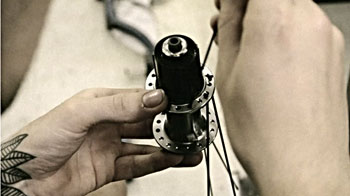
always one aiming to provide an element of choice and variation when it comes to the daily chore of reading, today's subject has a couple of options relating to the video at the bottom. you can either watch it before you read, or you can trudge through my narrative and then watch the movie as a reward. does it get any better than this?
what we like to describe as a wheel is, rather obviously, merely a collection of bits, those bits consisting of a hub, some spokes and a rim. proud as i am to point out that which is stunningly self-evident, putting the three together involves a modicum of forethought and some particularly nasty mathematics. the forethought is the easy bit, for assuming that all three components have been well chosen, the number of spoke holes on the hub should match the number of spoke holes on the rim. a frenzy of tautology i admit, but it might surprise you how often such a simple correlation goes awry.
the nasty mathematical bit relates to the length of the spokes, a calculation i will admit to being less than au fait with. when it comes to building my own wheels, i confess to using the spokes that i bought last time round. i can almost feel the sharp intake of breath from the purists; though front spokes will be the same length on both sides of the rim, the rear ought to have shorter ones on the drive side, due to wheel-dish. ok, i know we're only talking millimetres, but if those millimetres are threatening to punch through the rim tape, no matter how great the wheel looks, inner tubes are not going to last too long.
the world is well-served with experienced and expert wheelbuilders, notably big al in the wilds of scotland, jude kirstein of sugar wheelworks in portland, and darren at strada wheels. to this far from complete list, we need to add martin muller at condor cycles in london. when there are so many aspects of bicycle construction, design and maintenance to be studied and practiced, is martin a career wheelbuilder, or was he simply standing too near the truing stand when the job tickets were handed out?
"I started building wheels the same way most people start and then just took it a step further. I read a Sheldon Brown article on wheelbuilding, bought all the components, borrowed a Park Tools home mechanic stand and got going. I laced the wheel up and took it down to Brixton Cycles, my local bikeshop and asked 'is this right?', then took it back home and carried on. Later it was Art of Wheelbuilding and Bicycle wheel books, internet research and obviously asking those more experienced. And of course trial and error; a lot of trial and error."
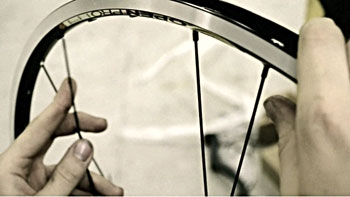
That is likely the way most folks with the ability to build wheels got started, though in my case, not having a local bike shop, i'd no-one to ask. to be honest, i would never have had the guts to ask a more experienced builder if i'd got it right. sadly my period of trial and error still continues. additionally, there's not a huge call for wheelbuilding on the inner-hebrides, so by the time the next pair trundles along, i've pretty much forgotten the approach i took last time. condor cycles is in a somewhat busier locale, so on average, how many wheels does martin build in a day. "On average probably around 4-5 sets."
ben leighton is a movie-maker whose main contribution to the world of moving pictures is that of both editor and online editor. his principal bread and butter involves commercials and promotional works in the cinema and factual tv industries, yet as an editor of some fifteen years standing, a movie about wheelbuilding is the first thing he's shot for himself. was he professionally schooled, or was it a case of figuring out the process for himself? "Bit of both: The filming I did instinctively; no pre-production or shot list or anything. I was looking forward to editing it while I shot, so I had a good idea about what I wanted; lots of close-ups of the parts, tools and the builder's body as he used it. It's interesting to me how he used his hands and fingers, knees, arms, eyes and ears to do all the things needed to make the wheel. I wanted to capture all the sounds of clanking of the rim, twanging spokes, scraping on the truing stand, to make them the narrative audio of the film."
so what made him opt for the subject of wheelbuilding? "I fancied editing something a bit different, in something that interested me, and to use some new edit kit I'd just acquired. My partner spotted an event run by The Crafts Council / V&A called 'The Power of Making', an open entry film event about craft. I'd been fiddling about with tensioned leather saddles for a while, stamping people's names in the hide and trimming and tying them, so that seemed an obvious choice of subject. But that would have meant filming myself, and to be frank I'm a bit bored of saddle stuff.
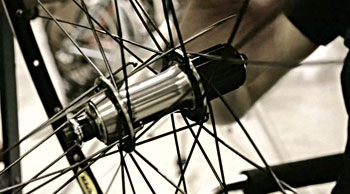
"Something got me thinking about the sheer craft of wheelbuilding. I had just finished a road set myself, in a pattern I'd never tried before (half radial rear, radial front) for my newly built road bike. As I struggled to true it to my satisfaction (I eventually got a pro to finish those wheels), I was reminded just how skilled a good wheel builder is. I've built a few wheelsets before by myself with pretty good results, like building 3x track wheels with no dishing, but when it gets a bit more complex, it takes a lot to get it right. The last rather good quality and expensive wheels I built last year, were built up by Martin before he was at Condor. So he seemed a good person to ask if I could film.
"One of my motivations for this was to show the skilled use of tools and one's senses, in a kind of mathematical but very dynamic, analogue sort of sphere; bending spokes around each other and tensioning them to make a wobbly uneven thing round. A lot of people on a certain forum I inhabit, build wheels for a few quid for their friends, but much less than shop prices. People there sometimes moan about shop prices for their wheels; I wanted to to remind everyone just what skilled people they are and by implication ask what their time and craft is worth. I think it's usually really good value."
while few would disparage that a professional wheelbuilder owns not only a skilled pair of hands, but a commensurately sharp brain, it seems that the influx of the factory built wheel, particularly now that many arrive with a new bicycle from the shop floor, may well have diminished the demand for 32 spoke, three-cross. does martin feel that the factory-built has decreased demand for the number of wheels he is requested to build? "I'd say it definitely has. however, it depends on what you need the wheel for and which end of the market we are talking about. if you're a╩ racer or have more money than sense, then a high end factory wheel will be better for you, because that's where the money is these days. They will be stiffer, lighter and blinger than a handbuilt set will ever be.
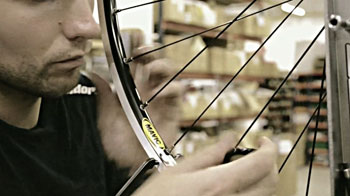
"But getting spares will be an expensive, time consuming process, as not every shop carries them, and your wheels won't last as long. If you'don't fit the above description, perhaps you're a cyclotourist, urban rider, commuter, bike messenger or you're just riding road for fun, then I'd recommend handbuilt all the way. These will be serviceable, fully customisable, with spares more readily available and they will last longer. Plus you'll probably know the person who built them and that they spent a good couple of hours making them to the best of their ability.
"I'd personally avoid lower level factory wheels like the plague."
martin makes a good point above, about probably knowing the person who built your wheels. though i'd be the last to criticise the upper reaches of the factory-built, professional builders have one glaring advantage over a machine; a sense of pride. in my earlier attempts at building, it was all too easy to end up with the valve hole between a pair of crossing spokes, not something that affects the intergity of the build, but a factor that can obfuscate the process of tyre inflation. it would have been simple to turn a blind eye, but i'd have been mortified to think that someone else would notice (and either cringe, or laugh). i am far from being a professional at such a black art, but builders such as martin put heart and soul into the construct: you are very unlikely ever to receive a wheel of which both of you are not proud.
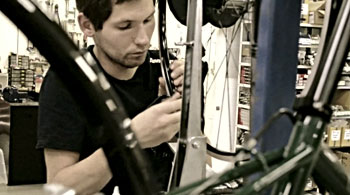
with this in mind, which aspects of martin's work was ben intending to portray?
"The care and skill that goes into this crucial element of a bicycle, one that most casual users or non-cyclists would never really consider. The definition of a 'craft' that I was working to, is the confluence of knowledge with creativity. I find wheels totemic of my love of building bicycles up. A nice wheel set is an absolute must for me, probably you, and no doubt most of the people who read thewashingmachinepost. I love older wheels, particularly the hubs; ancient Airlites, Campagnolo high flange hubs with the oil ports, those old chunky Mavic track hubs, and the older rims. The road pair I just built have CXP14s on which are really stiff and lovely. I have an early pair of steel-barrelled touring six speed bolt-on Phil Wood hubs that I literally adore. The rear one is a Hi-Lo just to really get my inner-nerd frothing. Phils were the first cartridge hubs I think, and these are wonderful. I have built them with Sapim Strong on the DS so they're more evened-out in tension."
since the factory build has its designs set on conquering the mainstream, often providing startlingly good looking wheels at low prices, does martin find he is asked for a wider variety of specifications, or is 32 spoke three-cross still king? "Mostly it is 3x on both wheels, but sometimes I'm mixing patterns/spoke gauges on the rear wheels to offset for the high dish. Twenty-eight spoke and less are obviously 2x,1x or radial and any hubs with large flanges or smaller rims are laced with fewer crosses. what about the bizarre spoke patterns at one time beloved of cycle messengers? is martin willing to accede to requests for such trendy stuff like snowflakes?
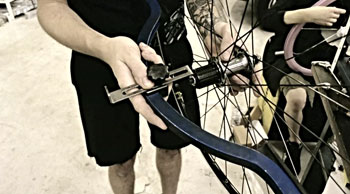
"Personally I think snowflakes╩are pointless and they look horrible, but if someone wants them Im happy to oblige as long as they are aware of the fact that their wheel will be less stable, will fatigue more and difficult to work on afterwards. The one exotic pattern I like the look of is Spanish three cross, but I'd never use it on my wheels."
much of contemporary cycling is infused with carbon fibre; wheels have not been excluded from this trend. has martin had experience of building with carbon rims? does it make the process harder or easier than with alloy rims? "I've built a couple, and yes it's definitely more difficult. The rims were very deep and full of junk so lacing was trickier. They mostly use internal nipples so both the measuring process and truing are more time consuming. additionally you have to have your trusted tension meter at the ready, because nobody wants a £300 rim to go 'POP'"
different builders use varying methods, taking differing amounts of time to complete a wheelset. some view it as a leisurely experience, a skill that takes the time it takes to complete the ultimate pair of hoops. how long did it take ben to complete filming? "35 minutes: as long as it took for Martin to build the wheel, probably slowed down a bit by me sticking a camera up his nose all the way through. I didn't set anything up or ask him to stop and wait or re-do things. I just wanted him to get into his normal rhythm of it, and tried not to distract him too much. When he finished, I just rushed home and started editing immediately."
what about martin? was it fun or nervewracking to find himself at the object end of the camera lens? "im one of those people who, as soon there is a photo or video camera around, starts asking ' How stupid will I look in the end product?' But it was alright, since wheelbuilding for me is an absorbing process and i didn't have to think about it." was ben a demanding cinematographer, or did he pretty much let martin get on with the job? He said just to build the wheel and not to worry about him. The only tricky moments were when I wanted to put my tools down, or to move myself or the wheel somewhere where his mic/camera was."
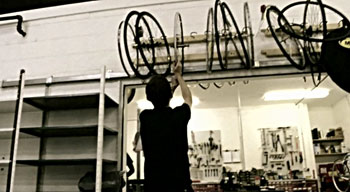
having completed a rather successfully made movie about wheelbuilding, has ben leighton any plans to make more, covering other aspects of bicycle ephemera? "Maybe. I have an idea for another, but it would take some time to achieve, unlike the wheelbuilding. I love cycling. I sometimes wonder what life would be like without cycles and I feel a shiver of dread. So I give thanks every day I get to ride." and what's the lifecycle for this one? "Entered at the Power of Making exhibition and I'd like to submit a longer version to the Bicycle Film Festival for 2012, more accurately representative of the process for the discerning cyclist."
and since he knows just what he'd be getting inside the wheelbag, does martin ride his own wheels? "always:-)"
posted thursday 4 august 2011
 ..........................................................................................................................................................................................................
..........................................................................................................................................................................................................